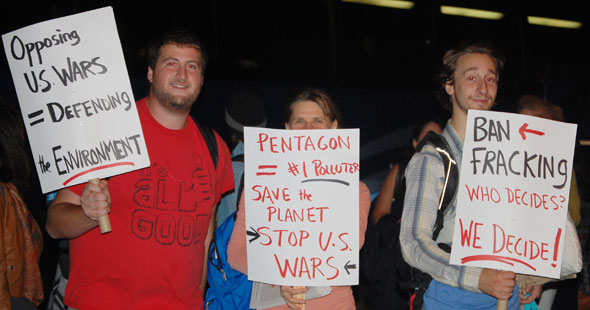Women's March on the Pentagon
• Fight for an Anti-War Government, Peace Economy and a Democracy Where
We Decide!
•
War: A Community Issue
• Schedule of Events
Fight for an Anti-War Government,
Peace Economy and a Democracy Where
We Decide!
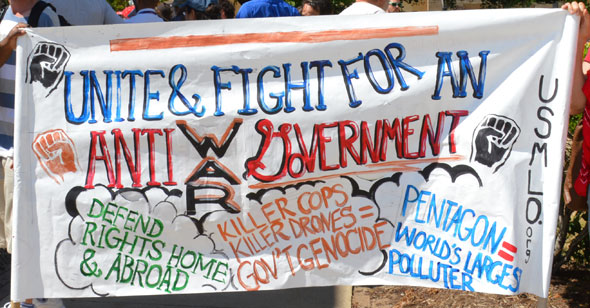
A salute to all those participating in the Women’s March on the Pentagon in Washington, DC October 20-21 and all the sister demonstrations in cities across the country. Organizing to put the issue of war and peace on the agenda and bring out its relationship to the many fronts of struggle for rights is a vital contribution to building and uniting the pro-social, anti-war movements of the peoples. The demands to Close All U.S. Foreign Bases and Bring All U.S. Troops Home Now are main ways to contribute to peace and building relations of mutual respect and benefit. This is what the peoples here and abroad want and are fighting for in many different ways. The U.S. Marxist-Leninist Organization (USMLO) joins all those working for the success of the action and for continued efforts in the future. We are putting forward as a unifying call and aim: Fight for an Anti-War Government, Peace Economy and a Democracy Where We Decide!
[TOP]
Political Power Key
We are all contending with conditions of retreat of revolution, where the most reactionary forces have the offensive and are imposing a brutal counter-revolution on the peoples. This is seen in the broadening of U.S. crimes of aggression and interference with no regard for rule of law, as well as the anti-social attacks at home. Defending the so-called national interest is being used to justify U.S. terrorism, whether in the form of drone warfare, sanctions, regime change, the attacks on immigrants and refugees, police killings, mass incarceration, further criminalizing protest and more.
Conditions are now such that public governing institutions, like Congress, the Courts, elections are dysfunctional. They do not sort out conflicts among the rulers, as the many fights between and within the military, presidency and intelligence agencies show. Nor do they serve to perpetuate the notion that there is the consent of the governed. All that is left is a government of police powers, where governments act with impunity and arbitrary violence against the people and their organized resistance. The rulers are no longer concerned with legitimacy, only with preserving their power.
While U.S. rulers are on the offensive, it is also the case that their system has shown itself to be unsustainable and unfit for human existence. The massive human productive powers that exist CAN solve the problems faced by humanity, like poverty, inequality, climate change and nuclear war. The human beings who collectively produced these powers are capable of controlling them and unleashing them in the interests of humanity. But it requires political power in the hands of the people. It requires the power to decide the affairs of society, including providing a new direction for the economy and politics.
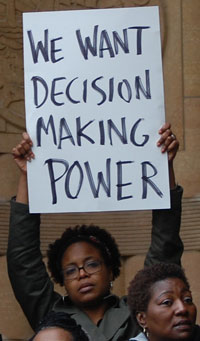 Recognizing the significance of these relations and the need for political power, USMLO puts forward as a unifying call and aim: Fight for an Anti-War Government, Peace Economy and a Democracy Where We Decide! All those calling for peace, closing bases, divesting from the war machine and fossil fuels; calling for equality and rights to housing, healthcare, jobs and education; defending Mother Earth and opposing the energy and war oligopolies; all those standing up for rights have an interest in taking up the aim of an anti-war government. We need a government that responds to the demands of the people, the broad majority, to end U.S. wars and contribute to defending the rights of ALL at home and abroad. We need a peace economy that provides a new direction that stands against war and for rights. Steps in that direction can be taken today. For example, in New York, there is a proposal to close the Niagara Air Base, used for drones and mid-air refueling of jets to bomb Yemen, and instead turn it into a solar farm.
Recognizing the significance of these relations and the need for political power, USMLO puts forward as a unifying call and aim: Fight for an Anti-War Government, Peace Economy and a Democracy Where We Decide! All those calling for peace, closing bases, divesting from the war machine and fossil fuels; calling for equality and rights to housing, healthcare, jobs and education; defending Mother Earth and opposing the energy and war oligopolies; all those standing up for rights have an interest in taking up the aim of an anti-war government. We need a government that responds to the demands of the people, the broad majority, to end U.S. wars and contribute to defending the rights of ALL at home and abroad. We need a peace economy that provides a new direction that stands against war and for rights. Steps in that direction can be taken today. For example, in New York, there is a proposal to close the Niagara Air Base, used for drones and mid-air refueling of jets to bomb Yemen, and instead turn it into a solar farm.
United actions that recognize pro-active aims, like an anti-war government, are needed. Demonstrations today are mainly for purposes of uniting people, taking a public stand for the public, developing political discussion on aims and strengthening the organized character of resistance. In conditions of a government of police powers, the issue is not so much how many are in the streets, but rather how demonstrations, conferences, public forums, independent media, all contribute to elaborating common aims and common thinking.
Political Discussion from Our Vantage Point
 We need political discussion on how to look at problems from our own independent vantage point and organize in such a way that change to our advantage can be brought about. It is necessary to break with the vantage point of the rich, which says our role is limited to appealing to them to do what is right and just. Our role is to organize to be the decision-makers, to decide what is needed to win political power and take steps to get there.
We need political discussion on how to look at problems from our own independent vantage point and organize in such a way that change to our advantage can be brought about. It is necessary to break with the vantage point of the rich, which says our role is limited to appealing to them to do what is right and just. Our role is to organize to be the decision-makers, to decide what is needed to win political power and take steps to get there.
For example, in elections our role is not mainly to vote or not vote. It is to fight to be decision makers every step of the way, from deciding the agenda and the candidates and more generally developing an electoral process that empowers the people to govern and decide. This includes demanding now that all candidates take a stand on issues of war and peace and issues of democracy.
An anti-war government requires a new direction for politics and the economy. It requires a modern democracy, where the rights of all are at the center and the right of the people to govern and decide is advanced. All those demanding peace and justice have an interest in demanding a modern democracy, where we decide!
We welcome debate on this issue and urge all to join the Fight for an Anti-War Government, Peace Economy and a Democracy Where We Decide!
War: A Community Issue
War affects everyone. While some are adversely affected more than others, there is no one that escapes the war machine's reach. One example in the United States is war funding. The defence budget is mind-boggling. The U.S.'s 2019 Pentagon budget supports 883 overseas bases and is lethal to humanity. Instead of terrorizing our brothers and sisters abroad, the billions of dollars spent on war could be used for a host of issues at home including almost every one that people take to the streets about. From education to health care and from infrastructure to the environment -- the war machine strips money, time and attention from all of it. In some cases, U.S. imperialism not only prevents these issues from receiving the time, energy and money they need, but it also exacerbates the problems.
The U.S.'s Toxic 2019 "Defense" Budget
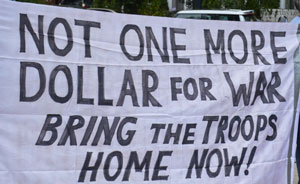 [...] More than one hundred years after World War I, we are engaged in endless wars, expensive, costly endless wars. In addition to the vast human toll, how much does endless war -- and a growing number of U.S. bases around the world -- cost financially each year? This is an attempt to do a reasonable calculation of the cost in public taxpayer dollars of our hundreds of bases stationed around the world (those which are mostly outside the theatre of war), commencing with the end of The Great War. I undertook this exercise using my decades-long background in accounting, available public reports, articles, research papers, books (to connect the dots), interviews with current and former military personnel, and common sense. Well, as much common sense as possible given the U.S. military budget is the largest of any country in the world, as much as the next 10 countries' military budgets combined.
[...] More than one hundred years after World War I, we are engaged in endless wars, expensive, costly endless wars. In addition to the vast human toll, how much does endless war -- and a growing number of U.S. bases around the world -- cost financially each year? This is an attempt to do a reasonable calculation of the cost in public taxpayer dollars of our hundreds of bases stationed around the world (those which are mostly outside the theatre of war), commencing with the end of The Great War. I undertook this exercise using my decades-long background in accounting, available public reports, articles, research papers, books (to connect the dots), interviews with current and former military personnel, and common sense. Well, as much common sense as possible given the U.S. military budget is the largest of any country in the world, as much as the next 10 countries' military budgets combined.
Among the many resources used in this analysis was the 116-page "Defense Budget Overview, U.S. Department of Defense [DoD], Fiscal Year 2019 Budget Request" (The Report), in which the 2019 request was $686.1 billion, an increase of 13 per cent or $74 billion, over 2018.
The Report is less a "defence" budget; rather it is more a document oozing threats to worldwide lethal annihilation:
"The strategic goals for Fiscal Years 2018-2023 reflect the Secretary's priorities:
(1) Increase the lethality of the Joint Force;
(2) Strengthen U.S. alliances and build new partnerships;
(3) Reform the Department to reinvest resources in warfighter priorities" (The Report, p. 9-3).
If the planet is our community, the U.S. is the bully in the neighbourhood. References to the word "lethal" are sprinkled no less than three dozen times throughout The Report ("more lethal force" (p. 2-6), "technology innovation for increased lethality" (p.1-1), "increasing the lethality of new and existing weapons systems" (p. 3-2)).
Among the DoD's goals is the Orwellian "preserving peace through strength" and "protecting the American way of life" (a way of life in which every minute four people are served with eviction judgments, 30 million have no access to health care, $1.5 trillion is owed in suffocating student loan debt, and 63 per cent of the population cannot afford a $500 emergency repair).
Were it not for The Report's dire (yet fully funded) predictions for world domination, one would think this budget request was satire. From page 2-4, the Foreign Affairs Strategic Approach for the upcoming year states: "To succeed in the emerging security environment, the Department and Joint Force will have to out-think, out-maneuver, out-partner, and out-innovate revisionist powers, rogue regimes, terrorists, and other threat actors."
And again, the number one goal is to "Build a more lethal force."
In a world where money is no object, The Report specifically details the following purchasing priorities for 2019:
• Increasing the strength of the Army, Navy, and Air Force by almost 26,000;
• Buying ten combat ships ($18.4 billion);
• Increasing production of the F-35 aircraft and F/A-18 aircraft ($12.7 billion);
• Enhancing deterrence by modernizing the nuclear triad; and
• Increasing the emphasis on technology innovation for increased lethality.
Additionally, The Report states: "The DoD has expended more munitions than planned over the last few years, primarily to defeat Islamic State of Iraq and Syria (ISIS), leading to higher demand to replenish munition inventories" (p. 3-6). Addressing these needs, the 2019 budget request increases by over 28,300 the amount of production for the following munitions:
• Guided Multiple Launch Rocket Systems;
• Advanced Precision Kill Weapon Systems;
• Joint Direct Attack Munition;
• Small Diameter Bomb 1 (includes spares);
• Hellfire rockets; and
• Army Tactical Missile Systems.
Total increased cost in the 2019 budget for these munitions is $8.1 billion (p. 3-7). In a surprise (yet not really) admission, The Report states that "major power competition, not terrorism, is now the primary concern in U.S. national security" (p. 2-1).
But let us back up a minute. More historical perspective is relevant at this point, if only to grasp the enormity of U.S. spending over the last 18 years on endless wars around the globe.
War Funding
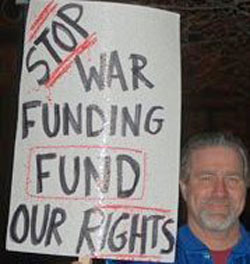 One hundred years ago, World War I financial costs for the U.S. were about $22.6 billion, which is $328 billion today, adjusted for inflation. The 2019 DoD budget request is $686.1 billion, or twice what it cost the U.S. during WWI in today's dollars.
One hundred years ago, World War I financial costs for the U.S. were about $22.6 billion, which is $328 billion today, adjusted for inflation. The 2019 DoD budget request is $686.1 billion, or twice what it cost the U.S. during WWI in today's dollars.
Included in the DoD 2019 budget request of $686.1 billion, is $89 billion for Overseas Contingency Operations (OCO), which predominantly funds the wars (operations, in-theatre support, classified programs, coalition forces, counter-ISIS training, security, etc.). Specifically stated areas include Afghanistan, Iraq, Syria, and "other mobilization" sites.
According to The Report, OCO funding alone for the 18-year period beginning in 2001 through 2018 totalled $1.8 trillion (p. 1-3), or almost $101 billion per year -- an amount which approximates the annual combined budgets of the U.S. Department of Education ($60 billion), Department of Health & Human Services ($18 billion), Department of Transportation ($15.6 billion), and Department of Labor ($9.4 billion). [...]
883 Military Bases Around the World and Growing
Pouring through various documents, publications, books, and research papers, I developed a list of countries with U.S. military bases outside the U.S. This list includes U.S. territories (Guam, U.S. Virgin Islands, Mariana Islands, American Samoa, and Puerto Rico) and bases in 183 countries, on seven continents and seven bodies of water. This number does not include U.S. embassies and may or may not include other sites such as lily pads (smaller, temporary, and/or not authorized sites) and special operations sites.
Some publicly available documents, from the U.S. government, contradict one other. For example, the Army's most recent average cost per person is just under $100,000 ($94,300). However, other Defense documents calculate average cost per person at $55,000. I could not find a single, comprehensive document which accounted for the total cost of overseas bases (additionally, many excluded the cost of bases on U.S. Territories), so I took data available from a number of resources to calculate the costs contained herein. Where contradictions occur, I so note.
Buildings and Structures
I started with the Department of Defense Fiscal Year 2019 Budget Request which acknowledges $2.6 trillion in assets on the balance sheet of the Department's books (p. 6-2). Of these assets, another report -- The Base Structure Report Fiscal Year 2017 states:
The DoD manages a worldwide real property portfolio that spans all 50 states, eight U.S. territories with outlying areas, and 41 foreign countries. The majority of the foreign sites are located in Germany (120 sites), Japan (121 sites) and South Korea (78 sites) (p. DoD-6).
The Base Structure Report identifies a total of 4,793 sites worldwide, at a value of $1.046 trillion, covering 27.2 million acres of land. Of the 883 sites identified, The Base Structure Report verifies 110 sites located in U.S. Territories and another 517 sites overseas, for a total of 627 sites outside the U.S. with a September 30, 2016 value of approximately $200 billion.
This worldwide portfolio of 4,793 sites on over 27 million acres includes:
(1) Buildings: "The DoD occupies a reported 275,504 buildings throughout the world, valued at over $705 billion and comprising over 2.2 billion square feet (p. DoD-8)." The buildings include administrative, community facilities, family housing, hospitals and medical, maintenance, production, operation and training, research and development, testing, supply, troop housing, mess facilities and utility and ground improvements.
(2) Structures: DoD structures throughout the world are valued at over $162 billion.
(3) Linear Structures: DoD manages over 112,931 linear structures throughout the world at a value over $178 billion. Linear structures are facilities whose functions require that it traverse land (examples include runways, roads, rail lines, pipelines, fences, pavement, and electrical distribution lines).
The difference between my estimate of overseas bases of 883 and the 627 mentioned in the Base Structure Report may be reconciled as follows:
(1) The DoD will be undergoing one of the largest consolidated DoD-wide financial statement audits in Fiscal Year 2018, which will involve both general funds and working capital funds. A focus of the audit will be "the discovery of Real Property and General Equipment not being recorded in the proper system (p. 6-3)." (It is anticipated, based on prior audits, that not all overseas sites assets -- i.e. buildings, roads, and structures -- are recorded on the books of the DoD.)
(2) The 883 bases include 95 sites which are smaller sites and may or may not be in the Base Structure Report.
(3) The Base Structure Report identifies 517 sites worldwide (exclusive of U.S. Territories), but a count in the detail in this same report (pp. DoD-70 to DoD-85) resulted in a total of almost 600 sites.
Combatant Command Exercise and Engagement
The Report identifies ten Combatant Command Exercise and Engagement programs and lists the following nine:
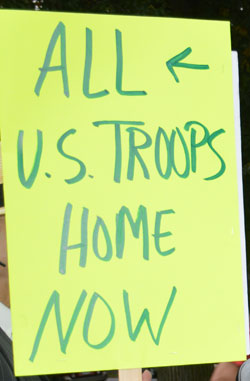 • USAFRICOM (Africa);
• USAFRICOM (Africa);
• USCENTCOM (Kingdom of Jordan);
• USCYBERCOM (virtual environment);
• USEUCOM (Europe);
• USNORTHCOM (homeland defence);
• USPACOM (Korea);
• USSOUTHCOM (Latin America);
• USSTRATCOM (nuclear deterrence);
• USTRANSCOM (full spectrum global mobility).
The Report's costs include:
(1) Fixed costs which are costs that do not change if a particular site is not occupied. Examples include: rent/mortgage payments, property taxes, insurance, maintenance.
(2) Variable costs which do change based on occupancy. Examples include utility consumption, repair and maintenance, cleanup, trash removal, increased costs due to surrounding neighbourhood activity.
A 2013 Rand Corporation research report, acknowledged that overall costs are higher overseas even when taking host-nation support into account. I took a conservative approach in the following calculations.
Personnel
Of the roughly 2 million military personnel, including reserves and National Guard, approximately 12 per cent, or 238,000 are deployed to overseas bases (outside of OCO). Personnel includes base pay, payroll taxes, bonuses (sign on and incentive), pension, uniforms, transportation, basic training/boot camp, life insurance, education, weapon assignment, and annual allowances for uniform and weapon upkeep. In order to calculate this cost, I started with the daily basic pay for military personnel, and built upon that cost with the aforementioned burdens, and pro-rated amounts for overseas costs.
Annual Cost of Personnel: $22.9 billion
Transportation
Transportation costs include Army, Air Force, Marine, Navy and National Guard and represent costs to move personnel to overseas locations and back. According to The Report, "Overseas Basing of U.S. Military Forces, 2011," average annual cost for overseas transportation per person was $5,200, and varied depending on place of deployment.
Annual Cost of Transportation: $1.3 billion
Maintenance of Facilities
The DoD occupies or maintains buildings, facilities, and linear structures worth over $1 trillion worldwide. The value of the overseas portfolio is about $200 billion, covering about 50,000 structures. Applying a standard no-less-than-one-per-cent-per-value of the asset, plus insurance, plus capital improvements, and contingency, I came up with annual cost of maintenance of overseas (including U.S. Territories) bases.
Annual Cost of Maintenance of Facilities: $7.5 billion
Construction
The 2019 DoD budget request includes an increase in the OCO budget of an additional $17 billion for facilities construction overseas.
Previous and current year construction projects include:
• The Kaiserslautern Military Community Center in Germany, an eight-storey, 844,000 square foot Air Force facility which includes a 350-room visiting quarters, a four-plex movie theatre, Power Zone, Outdoor Living, Toyland/Four Seasons, food court, new car sales and other vendors in a U.S.-style mall layout, and a two-storey climbing wall. It is intended to house about 50,000 military members and their families. Construction costs are difficult to ascertain (because the Air Force is not tracking the total cost of this facility, which has experienced multiple construction-related delays, deficiencies, and overruns). Total cost is expected to exceed $215 million.
• New construction of the Landstuhl Military Hospital in Germany, which is expected to be slightly less than $1 billion ($990 million) and to be completed in 2021. This hospital is expected to replace the Landstuhl Regional Medical Center as the military's main European medical facility.
• New construction of the medical material warehouse at Kadena Air Base in Japan. Cost for this building is expected to be more than $20 million.
Total cost of construction for the three aforementioned facilities is over $1.2 billion.
Taking into account the cost of overseas construction, the DoD 2019 budget request for overseas construction and applying a multiplier factor, I came up with a conservative estimate of the annual cost of construction (because not all money will be spent in one year's time.)
Annual Cost of Construction: $4.8 billion
Health Care
The DoD 2019 budget request acknowledges health care costs run about 9 per cent of the DoD budget (excluding long-term care or disability-related or permanent injuries.) Health care costs include use of Veterans Affairs facilities, Tricare, and combat casualty care for members and their families.
Annual Cost of Health Care: $5.9 billion
Training
Estimated cost of training for overseas personnel takes into effect (a) direct equipment parts, (b) fuel costs, (c) post production software costs, and (d) indirect support costs. Calculating training costs for Army, Navy, Air Force, Marine, and others, and considering total historical costs per year for NORTHCOM, AFRICOM, and SOUTHCOM of $980 million in 2012 costs, I applied annual cost of inflation increases, and with contingency, came up with an annual cost for ongoing training exercises for military personnel.
Annual Cost of Training: $1.0 billion
Environmental Remediation
 Environmental contamination is a by-product of weapons and ballistic testing and training for all divisions of the military. Add to that burn pits, depleted uranium, destroyed species on both land and water, poisoned water supplies, and ongoing cleanup of nuclear testing fallout, to name a few.
Environmental contamination is a by-product of weapons and ballistic testing and training for all divisions of the military. Add to that burn pits, depleted uranium, destroyed species on both land and water, poisoned water supplies, and ongoing cleanup of nuclear testing fallout, to name a few.
As an example, Guam, at 210 square miles, is home to dozens of U.S. military bases. Its ecosystem suffered tremendously when brown snakes were introduced to the island, entering over the decades with U.S. military equipment. These 2 million brown snakes have shorted out electrical systems, devastated new tree growth, and knocked out entire species of birds.
According to Science Alert, "10 of 12 bird species native to Guam had vanished, including a kingfisher that cannot be found anywhere else on Earth." The military has spent no less than $12 million alone trying to eradicate this problem.
Annual Cost of Environmental Remediation: $1.3 billion
Allowances and Site Costs
Allowances and site costs for Army, Air Force, Marines, and Navy include base allowance for housing, overseas housing allowances, cost of living allowances, and family separation allowances. Average annual cost per person is $25,900.
Annual Cost of Allowances and Site Costs: $3.3 billion
Military Family Support
The 2019 DoD budget request for military family support totals $8.1 billion and includes: (1) child care and youth programs; (2) morale, welfare, and recreation; (3) warfighter and family services; (4) commissary; (5) Department of Defense overseas schools; and (6) Military spouse employment.
Annual Cost of Military Family Support: $2.4 billion
The above cost estimate does not include:
• Extended medical and long-term care of partially and permanently disabled veterans;
• Legal costs of criminal activity committed by military personnel at permanent base sites;
• Payments to communities for reimbursement of base-related neighborhood costs;
• Negotiation, legal, and otherwise for land protection, remediation, and extraction of resources.
RECAP:
Cost of Personnel: $22.9 billion
Transportation: $1.3 billion
Maintenance of Facilities: $7.5 billion
Construction; $4.8 billion
Health Care: $5.9 billion
Training: $1.0 billion
Environmental Remediation: $1.3 billion
Allowances and Site Costs: $3.3 billion
Military Family Support: $2.4 billion
Total Annual Cost of Military Overseas Bases: $50.4 billion
Add
Overseas Contingency Operations (funding the wars): $89.0 billion, included in The Report.
Total Estimated Annual Cost of Overseas Operations: $139.4 billion
War is not normal activity. The DoD 2019 budget clearly articulates the ramp up of military forces, the expansion of military "solutions" worldwide. Conversation is desperately needed about the U.S.'s lethal role in the destruction of our planet.
Lynn Marie Petrovich is a guest blogger on Cindy Sheehan's Soap Box Radio Show.
(Edited slightly for style and clarity)
[TOP]
2018 WOMEN'S MARCH ON THE PENTAGON
In response to the continuing march of military aggression by the USA and to put an antiwar agenda back on the table of activists, we are calling for a Women's (and allies) March on the Pentagon on the 51st anniversary of the 1967 big antiwar event in DC and subsequent march on the Pentagon that had 50,000 people! Our demands are simple: The complete end to the wars abroad; closure of foreign bases; dramatically slash the Pentagon budget to fund healthy social programs here at home: the only good empire is a gone empire. We Must March for Peace and Against the War Machine!
Schedule of Events
Saturday, October 20
St. Stephen and the Incarnation Episcopal Church
1525 Newton St NW, Washington, DC 20010
1:00 - 2:00 : VICTIMS NO MORE
Basics of self-defense for women. Led by F.U.R.I.E.
1:00 - 2:30 : ANTI-IMPERIALIST SONG SWAP AND SING ALONG
Has music helped you clarify your commitment to anti-Imperialist struggle? For generations singers throughout the world have used song to give voice to their struggle for self-determination and freedom against the threats of war. Participants are invited to share a song that builds on this tradition. We may also leave some room for discussion about the particular role musicians can play in building anti-imperialist movements.
Workshop Leaders: Ben Grosscup, People's Music Network for Songs of Freedom and Struggle & Sheri Bauer-Mayorga, song leader. Additional leaders are welcome. We want this to be a participatory space!
2:30 - 3:30 : NONVIOLENT CIVIL RESISTANCE AGAINST THE WAR MACHINE: A gathering to discuss and learn about nonviolent witnessing against the empire of violence. Have you ever been led to consider risking arrest to speak out against war and social injustices? Are you someone who was arrested for a cause some time ago but haven't in a long time? Are you being led to witness for peace and justice but have concerns you would like to explore. Joy First and Malachy Kilbride have organized and participated in acts of nonviolent civil resistance and between them have over 100 arrests. They have worked with National Campaign for Nonviolent Resistance, Witness Against Torture, Declaration for Peace, Campaign Nonviolence, and other groups speaking out and witnessing against those in power who continue the wars against the people and Mother Earth. Joy and Malachy will share their stories and lead a discussion about how we are led to speak out and risk arrest confronting the War Machine.
3:30 - 4:30 : ALTERNATIVE MEDIA
How to be our own media in the capital of propaganda. Hear from a panel of people working in independent media and discuss the recent Facebook purge of antiwar voices.
4:30 - 5:00 : WHAT'S REALLY HAPPENING IN YEMEN
Learn more about what is happening on the ground in Yemen, who is involved in the conflict, and what you can do.
5:30 - 8:00 : MEET & GREET / OPEN MIC NIGHT
Sponsored by CODEPINK. Sign-ups are first come/first served.
Sunday, October 21
 11:00 am to Noon: Gather at Pentagon City Metro Station
11:00 am to Noon: Gather at Pentagon City Metro Station
Noon to 1:00 pm: MARCH ON THE PENTAGON, led by Malachy Kilbride
1:00 pm until 4:00: Rally with speakers/music/entertainment
Speakers to include: Members of Dragonfly Inter-tribal all Woman Drum Group, Cindy Sheehan, Bonnie Caracciolo, Emma Fiala, Mnar Muhawesh, Ann Wright, Alison Weir, Deb Della Piana, Chelsea United Against the War, Walter Teague, Jill Stein, Nick Brana, Eleanor Goldfield, Kevin Zeese and Margaret Flowers, Medea Benjamin, YahNé Ndgo, F.U.R.I.E., Students and Youth for a New America, WMOP Steering Committee, Bruce A. Dixon, Sameera Khan, and the WMOP Advisory Committee
Musical guests to include: Ariel Zevon, the Raging Grannies, the DC Labor Chorus, Pam Parker, Sheri Bauer-Mayorga and Ben Grosscup
[TOP]

